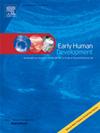越南一家三级医院早产儿出生后巨细胞病毒感染:发病率、特征和短期结果
IF 2
3区 医学
Q2 OBSTETRICS & GYNECOLOGY
引用次数: 0
摘要
出生后巨细胞病毒(pCMV)感染对早产儿具有重大风险,加剧了与早产相关的短期和长期并发症。方法本前瞻性队列研究纳入了2022年1月至2023年5月在越南某三级医院NICU住院的早产儿。婴儿在出生后的前3周使用尿液聚合酶链反应(PCR)筛查先天性巨细胞病毒(cCMV)。需要延长住院时间(3周)的婴儿表现出不利的临床病程,随后对pCMV进行PCR检测。结果271例早产儿中,cCMV和pCMV的检出率分别为0.74%(2/271)和26.57% (72/271),pCMV检出率为42.35%(72/170)。pCMV的主要临床表现包括呼吸暂停/氧气需求增加、中性粒细胞减少、血小板减少和天冬氨酸转氨酶升高。与未感染的婴儿相比,pCMV患儿需要ROP治疗的风险更高(aOR 2.21;95% ci 1.04-4.67;p = 0.039),发展为BPD 2-3期(aOR 2.30;95% ci 1.08-4.89;P = 0.031),住院时间较长。结论pcmv感染在早产儿中较为常见,并与严重ROP、BPD晚期及延长住院时间相关。这些发现强调了早期筛查和量身定制的干预措施的必要性,以减轻早产人群中pcmvv相关并发症。本文章由计算机程序翻译,如有差异,请以英文原文为准。
Postnatal cytomegalovirus infection in preterm infants at a tertiary hospital in Vietnam: Incidence, characteristics, and short-term outcomes
Background
Postnatal cytomegalovirus (pCMV) infection poses significant risks to preterm infants, exacerbating both the short- and long-term complications associated with prematurity.
Methods
This prospective cohort study included preterm infants admitted to the NICU of a tertiary hospital in Vietnam from January 2022 to May 2023. Infants were screened for congenital CMV (cCMV) using urine polymerase chain reaction (PCR) within the first 3 weeks of life. Infants requiring prolonged hospitalization (>3 weeks) who showed unfavorable clinical courses underwent subsequent PCR testing for pCMV.
Results
Among 271 preterm infants, the incidences of cCMV and pCMV were 0.74% (2/271), and 26.57% (72/271), respectively, while pCMV was detected in 42.35% (72/170) of those tested. The key clinical manifestations of pCMV included increased apnea/oxygen requirements, neutropenia, thrombocytopenia, and elevated aspartate aminotransferase. Compared to non-infected infants, those with pCMV had higher risks of requiring treatment for ROP (aOR 2.21; 95% CI 1.04–4.67; p = 0.039), of developing BPD stage 2–3 (aOR 2.30; 95% CI 1.08–4.89; p = 0.031), and experienced longer hospitalizations.
Conclusion
pCMV infection is common among preterm infants, and is associated with severe ROP, advanced BPD stages, and extended hospitalization. These findings highlight the need for early screening and tailored interventions to mitigate pCMVassociated complications among preterm populations.
求助全文
通过发布文献求助,成功后即可免费获取论文全文。
去求助
来源期刊

Early human development
医学-妇产科学
CiteScore
4.40
自引率
4.00%
发文量
100
审稿时长
46 days
期刊介绍:
Established as an authoritative, highly cited voice on early human development, Early Human Development provides a unique opportunity for researchers and clinicians to bridge the communication gap between disciplines. Creating a forum for the productive exchange of ideas concerning early human growth and development, the journal publishes original research and clinical papers with particular emphasis on the continuum between fetal life and the perinatal period; aspects of postnatal growth influenced by early events; and the safeguarding of the quality of human survival.
The first comprehensive and interdisciplinary journal in this area of growing importance, Early Human Development offers pertinent contributions to the following subject areas:
Fetology; perinatology; pediatrics; growth and development; obstetrics; reproduction and fertility; epidemiology; behavioural sciences; nutrition and metabolism; teratology; neurology; brain biology; developmental psychology and screening.
 求助内容:
求助内容: 应助结果提醒方式:
应助结果提醒方式:


